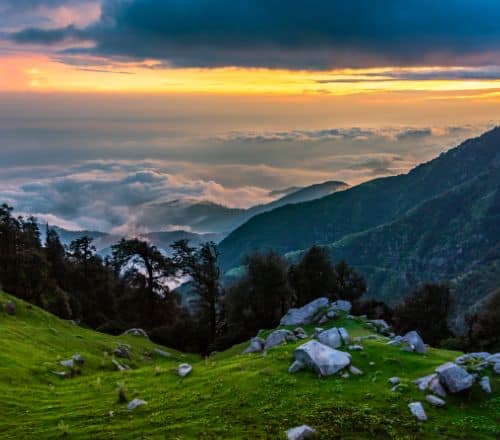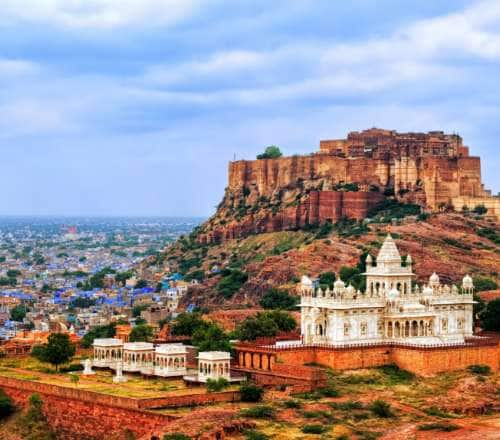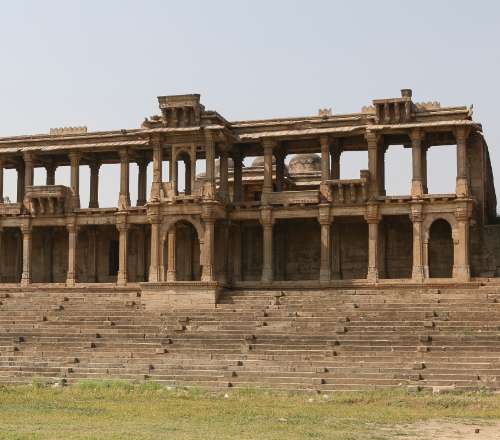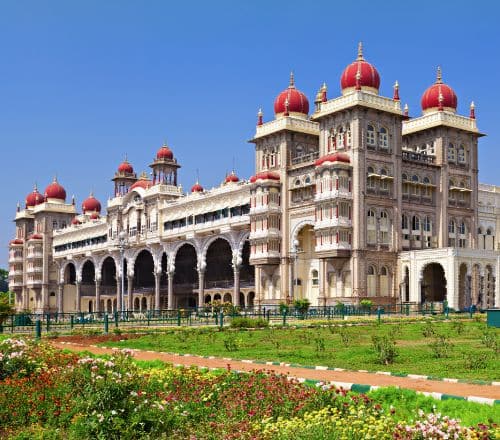Stay logged in to proceed with bookings, orders and offers.
On changing the terminal, you will loose items in your cart. Are you sure you want to change your terminal?
Amid a striking landscape of huge boulders, palm groves, and paddy fields stand these 10 magnificent temples, which provide a glimpse into the rich history, culture, and architecture of Hampi.
Did you know Hampi was among the richest cities in India once upon a time and attracted traders from Europe and Persia? Located on the banks of the Tungabhadra river in the state of Karnataka, Hampi served as the capital of the Vijayanagara Empire in the 15th century. In its heydays, the site was home to splendid temples and palaces built by the Vijayanagara kings. However, it was plundered after the Battle of Talikota which was fought between the Muslim sultans of Bidar, Bijapur, Golconda, and Ahmadnagar and the Vijayanagara Empire in 1565.
Declared a UNESCO World Heritage Site in 1986, Hampi is home to the ruins of these temples from the days of the Vijayanagar Empire. The temple town has as many as 1,600 monuments, including palaces, baths, forts, temples, and gateways. But with so many temples to choose from, it may become overwhelming to decide which ones to visit and the ones that could potentially be skipped.
Hence, in this article, I will walk you through the 10 most popular temples in Hampi for your trip to this enchanting temple town.
Read More
Read Less
Legend has it that Lord Hanuman was born on Anjeyanadri Hill, which is in the central part of Anegondi. It is said Lord Hanuman was born to Anjana; hence, he was named Anjaneya. Thus, the hill – his birthplace – is called Anjeyanadri (or Anjana's Hill). At the top of the hill is this temple, dedicated to Lord Hanuman. The temple has an austere whitewashed exterior and is reached by a hike, which involves climbing 575 steps. However, the hike is well worth the effort because the views from Anjaneya Hill – especially during sunrise and sunset – are among the best in Hampi. Spend some time taking in the jaw-dropping views of the surrounding paddy fields, coconut tree plantations, and historical ruins.
The 15th-century Vijaya Vittala Temple is dedicated to Lord Vitthala who is believed to be an incarnation of Lord Vishnu. The massive temple complex contains numerous shrines, pavilions, and halls, each of which boasts elaborate carvings, unmatched by any other temple you'll see in Hampi. However, the pride of the place is occupied by the stone chariot and the musical pillars. Situated in the courtyard of the temple, the stunning stone chariot is a shrine devoted to Garuda, who is the Eagle mount of Lord Vishnu. On the other hand, the musical pillars in the Ranga Mantapa emit musical notes when tapped. The pillars are designed in a way to reproduce the sound of various Indian musical instruments.
One of the oldest structures in Hampi and the only continuously functioning temple here, Virupaksha Temple is devoted to Lord Virupaksha, who is believed to be another form of Lord Shiva. Established as a small shrine in the 7th century, it was later expanded into a large temple complex during the reign of the Vijayanagara Empire. In 1442, a 164-ft-high gopuram (gateway) was added to the structure. Even from afar, you cannot miss this iconic nine-tier tower dominating the skyline of Hampi. Among all the temples here, Virupaksha Temple was the only one that wasn't destroyed during the attack of the Deccan Sultanates in 1565. Don't miss the striking three-headed image of Nandi Bull, the sacred mount of Lord Shiva, here.
Dedicated to Lord Narasimha, one of the avatars of Lord Vishnu, this temple is famous for its splendid 22-ft-tall statue of the deity. Depicted as part man and part lion, Lord Narasimha is shown sitting in a cross-legged position, with the seven-headed Adishesha forming the canopy over his head. It is also the largest image carved from a single block of stone in Hampi. The intricate detailing on the statue is nothing short of awe-inspiring! Originally, the idol of Lord Narasimha had Goddess Lakshmi, his consort, sitting in his lap. The statue was badly damaged during the attack of the Deccan Sultanates in 1565. However, you can still see the hand from Goddess Lakshmi's idol resting on the back of Lord Narasimha's image.
Centrally located in Hampi, this 15th-century temple served as a private shrine to the kings of the Vijayanagara Empire. Devoted to Lord Rama, the temple boasts some of the finest relics and carvings that illustrate scenes from Ramayana. The relics also portray ceremonial processions of elephants, horses, dancers, and soldiers during Dasara (or Dusshera) as it was celebrated during the times of the Vijayanagara Empire.
Located near Lakshmi Narasimha Temple, this shrine was built to celebrate King Krishnadevaraya's victory over Udayagiri which lies in present-day Odisha. Built in 1513, the temple is dedicated to Bala Krishna which is the infant form of Lord Krishna. There is a massive slab within the temple that recounts the story of the king's conquest of Udayagiri. The highlight here is the mesmerising carving that depicts Lord Vishnu and his 10 incarnations. Additionally, look out for the intricate carvings of yalli (a mythical creature with the body of a lion and the head of a human or an animal) on the pillars of the temple.
There is an interesting legend associated with this temple which was built in 1500. It is believed that once Lord Ganesha ate so much food he felt his stomach was bursting. To prevent his stomach from exploding, he tied a snake around his waist. The legend is immortalised in the 8-ft-tall monolithic image of Lord Ganesha here. The idol is sheltered underneath a mandapa which is supported by exquisitely carved pillars. The Kadalekalu Ganesha Temple on Hemkuta Hill is another shrine that houses a 15-ft-tall monolithic statue of Lord Ganesha. The belly of Lord Ganesha here is represented by a Bengal gram which is called kadalekalu in the local language; hence, the name of the temple.
Situated adjacent to the Lakshmi Narasimha Temple, this temple enshrines a 3-ft-tall monolithic shivling. Carved from a single block of black stone, this shivling is the largest in Hampi. The shivling has three lines on it, depicting the three eyes of Lord Shiva. The shivling is housed in a stone chamber that doesn't have a ceiling, allowing sunshine to enter the shrine, and flood it with light. The shivling remains submerged in water throughout the year.
Built in 1534, the Achyutaraya Temple is among the last of the monuments that were constructed in Hampi before the decline of the Vijayanagara Empire. Dedicated to Lord Tiruvengalanatha, who is another form of Lord Vishnu, this temple was originally known as Tiruvengalanatha Temple. However, later, it came to be known as Achyutaraya Temple, after Achyuta Deva Raya, who ruled Vijayanagara Empire at the time. The temple has a shrine devoted to Garuda and is known for its beautifully carved walls, towers, and pillars. A few steps from the Garuda shrine is an open hall with carved pillars depicting soldiers riding yallis. Look out for carvings showing Lord Krishna playing the flute and Lord Vishnu blessing an elephant. The temple complex is located away from the touristy places in Hampi, so, it tends to receive fewer visitors.
Hemakuta Hill stands on the southern side of the village, overlooking the Virupaksha Temple. The hill is peppered with the ruins of more than 35 temples, which are notable for a different architectural style compared to the other temples you see in Hampi. This is because they were constructed before the reign of the Vijayanagara Empire in this region. These temples have pyramid-shaped roofs which bear resemblance to Jain temples. As a result, the temples are commonly mistaken as Jain temples. Most of these shrines are devoted to Lord Shiva. Come here at sunset to soak in the gorgeous views of the surrounding countryside.
Hampi is a treasure trove of wonders not just for history lovers, but also for adventure and nature enthusiasts. Although each temple here possesses a distinct character, it can be difficult to visit all the shrines over a day or two. This list will serve as a curated guide to see some of the most glorious architecture from the bygone era and to gain insight into the lives and culture of the Vijayanagara Empire. Additionally, consider hiring a professional guide in Hampi to make the most of your visit to this temple town.





The Adani One expressly disclaims all liability, direct and indirect, in respect to actions taken or not taken based on any or all the contents of this Blog. The Blog is an opinion of the contributor based on the collation of data from various sources and is provided only for information purpose. Adani One does not canvass, advertise, solicit, invite or induct for any product, merchandise, information, brand or any other materials mentioned in the Blog, nor does it obtain any monetary benefit from the same. Reader is advised to read and apply his/her intellect and discretion in this regard. Any Intellectual Property mentioned in this blog belongs to the rightful owner. We do not intent to claim any interest over the same.